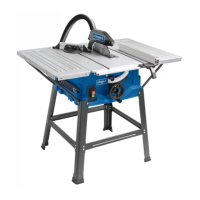www.scheppach.com
GB
|
39
10.1.1 Cutting narrow workpieces (g. 20)
Be sure to use a push stick (9) when making longitudi-
nal cuts in workpieces smaller than 120 mm in width. A
push block is supplied with the saw! Replace a worn or
-
require. (see 9.4)
-
the push stick (9) in the area of the saw blade.
-
splitter.
m Caution! With short workpieces, use the push stick
from the beginning.
10.1.2 Making angular cuts (g. 21)
stop (15).
- Set the blade to the desired angle. (See 9.3)
- Set the parallel stop (15) in accordance with the
workpiece width and height (see 9.4)
-
width (see 10.1).
10.2 Making cross cuts (g. 22)
- Slide the cross stop (7) into one of the grooves
-
the cross stop from making contact with the blade
guard.
- Use the stop rail.
-
(7).
- Switch on the saw.
- Push the cross stop (7) and the workpiece toward
the blade in order to make the cut.
- Important:
Always hold the guided part of the workpiece.
Never hold the part which is to be cut o.
- Push the cross stop (7) forward until the workpiece
-
until the blade has stopped rotating.
10.3 Cutting particle boards
To prevent the cutting edges from cracking when work-
blade (3) more than 5mm greater than the thickness of
the workpiece (also see 9.2).
10. Operation
Working instructions
trial cut in order to check the set dimensions.
After switching on the saw, wait for the blade to reach
its maximum speed of rotation before commencing with
the cut.
the cut (e.g. with a roller stand etc.)
Take extra care when starting the cut!
Never use the equipment without the suction function.
- 24 teeth: soft materials, large chip depth, coarse cut
-
10.1 Making longitudinal cuts (g. 19)
use the saw to cut along the grain of the wood.
Press one edge of the workpiece against the parallel
workpiece.
-
ing position that is in line with the cutting direction.
- Set the parallel stop (15) in accordance with the
workpiece height and the desired width. (See 9.4)
- Switch on the saw.
-
workpiece and push the workpiece along the paral-
lel stop (15) and into the blade (3).
- -
far as the front edge of the saw blade guard (4).
-
splitter (6).
-
the blade (3) is back in its position of rest.
-
of the cut (e.g. with a roller stand etc.) (e.g. roller
table etc.)

